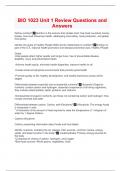BIO 1023 Unit 1 Review Questio ns and Answers Define nutrition? ✅Nutrition is the science that studies food: how food nourishes human bodies, how food influences health, addressing food safety, food production, and global food policy. Identify the goals of healthy People 2020 and its relationship to nutrition? ✅Nutrition is part of the U.S. national health promotion and disease prevention plan, Healthy PEople Goals: -Help people attain higher quality and longer lives, free of preventable disease, disability, injury and preventative death -Achieve health equity, eliminate health disparities, improve health for all -Create social and physical environments that promote good health -Promote quality of life, healthy development, and healthy behaviors across all life stages Differentiate between essential and nonessential nutrients? ✅-Essential (Organic) nutrients: contain carbon and hydrogen, essential components of all living organisms; they include carbohydrates, lipids, proteins, and vitamins -Nonessential (inorganic) nutrients: are those not containing carbon and hydrogen; they include minerals and eater Differentiate between calorie, Calorie, and Kilocalorie? ✅-Kilocalorie: The energy foods is measured in units * A kilocalorie is the amount of heat required to raise the temperature of 1 kilogram of water by 1 degree Celsius. Calorie=kilocalorie Calorie: presenting information about foods and food labels Identify nutrients, including the six classes, their sources, common names, energy yields, and basic function in the body? ✅-Carbohydrates: Primary energy sources for the body *Composed of chains of carbon, hydrogen, and oxygen *Best food sources: Whole grains, vegetables, fruits -Proteins: Support tissue growth, repair, and maintenance *Amino acid made up of carbon, hydrogen, oxygen and nitrogen. *Source: Meats, dairy products, seeds, nuts -Minerals: Assist with fluid regulation and energy production; maintain health of blood and bones *Sodium *Source: Fruits, vegetables, dairy products -Fats and oils: Important of energy at rest and during low -intensity exercise. *Carbon, hydrgoen, and oxygen *Source: Vegetables, oils, butter, and dairy Vitamins: Assists with release of macronutirents; critical to building and maintaining bone, muscle, and blood; support immune function and vision *Fat soluble and water -soluble compontents *Source: Fruits, vegetables, dairy products, meats Water: Ensures proper fluid balance: assist in regulation of nerve impulses, body temperate, and muscle contractions *Hydrogen and oxygen *Source: Water, juices, soups, fruits, vegetables. Calculate the percent intake of each of the energy yielding nutrients in a typical diet? EXAMPLE ✅Carbo/Protein= 4 kcal/g Alcohol= 7 kcal/g lipids= 9 kcal/g 300g of carbo X 4 kcal/g= 1200 kcal of carbo -(1200 kcal/2500 kcal)x 100 = 48% of total energy from carbohydrate 90 g of lipds x 9 kcal/g = 810 kcal of lipids (810 kcal/2500 kcal) x 100= 32.4% of total energy from lipids Apply the various standards utilized for DRI's (ie; EAR's, RDA's, AI's, EER's, UL's) and AMDR's✅DRI: Dietary Reference Intake; Aim to prevent and reduce risk of chronic disease and promote optimal health EAR: Estimated Average Requirement; The average daily intake level of a nutrient to meet the needs of half of the healthy people in a particular life stage or gender group




